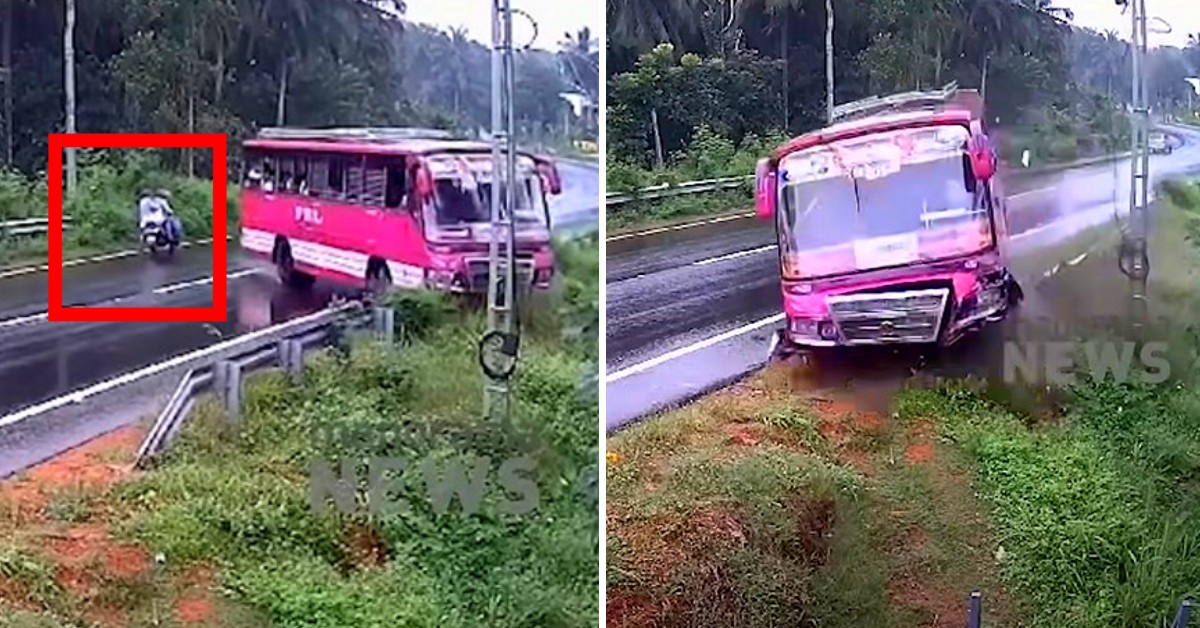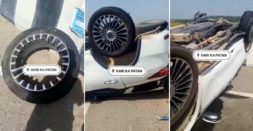While slippery roads make driving extremely dangerous, there is something even more perilous that remains hidden from plain sight. This CCTV footage shows a state-operated bus from Palakkad, Kerala, doing aquaplaning, which demonstrates how hazardous it can be.
In the footage, the speeding bus takes a turn on a curve and loses completely the traction on the rear wheels, causing it to slide and the driver to lose control. The bus then snaps back and hits the guard rail at a high speed. Fortunately, the guard rail saved the passengers from a potentially deadly fall. The CCTV footage shows panicked passengers stepping out of the bus after a few moments. Minor injuries were reported in this accident, but it could have been more dangerous.
Also read: 10 DC Design cars & how they look in the REAL world: Maruti Swift to Mahindra XUV500
How does aquaplaning happens?
![Aquaplaning bus nearly hits oncoming car and motorcycle in Kerala [Video]](https://www.cartoq.com/wp-content/uploads/2023/10/aquaplaning-bus-2.jpg)
Aquaplaning occurs when tyres cannot dissipate or remove the water from the surface, and the contact patch between the road and the tyre breaks, causing the vehicle to slide uncontrollably. Factors that lead to aquaplaning include insufficient tread depth of the tyre, high speed, and low air pressure in the tyre. Tread depth is crucial for maintaining optimum grip, and if it is less than 2mm, driving during the rainy season is not recommended.
Tyres with almost-bald treads cannot collect and throw water away to ensure proper contact surface with the road. Driving too fast can also limit the tyre’s ability to remove water. Low air pressure within the tyre causes flexing that allows water buildup on the surface, which leads to aquaplaning. Overfilled tyres are also not advisable since the contact patch reduces considerably.
If you experience aquaplaning, you will feel an extremely light steering and a loss of control over changing the vehicle’s direction. You may also notice the tachometer reading rising as the wheels lose traction.
During aquaplaning, there is not much you can do except lifting your foot from the accelerator. Attempting to steer may cause the vehicle to turn over when the tyres regain contact with the road surface. It is best to stay calm and wait for the vehicle to slow down and regain control of the steering wheel.
Can you avoid aquaplaning altogether?
Yes, you can by following simple steps. First and foremost, slow down. This is crucial as aquaplaning can be entirely avoided if you cross water at speeds under 40 km/h. If you spot a pool of water on the road, simply slow down as much as possible.
The condition of your tyres plays the second most important role in preventing aquaplaning. Regularly check the tyre condition and measure the tread depth. Anything below 4mm is considered dangerous. Make sure your tyres are properly inflated with the recommended air pressure provided by the manufacturer. This ensures that the tyres are not underinflated.
It is also advisable to disengage the cruise control system during rainy drives, as it can be difficult to modulate the accelerator input according to the road conditions. Always drive without engaging cruise control in wet weather.
Also read: Upcoming 2022 Maruti Suzuki Vitara Brezza rendered






![73 year-old MG car from India finally reaches England covering 11,000 km [Video]](https://www.cartoq.com/wp-content/uploads/2023/11/mg-vintage-car-road-trip-featured-253x131.jpg)


![Man Overfills And Spills Diesel Onto Mahindra Scorpio-N for Instagram Reel: Cops Seize SUV [Video]](https://www.cartoq.com/wp-content/uploads/2024/07/scorpio-n-owner-wasting-fuel-featured-253x131.jpg)
![Mahindra Scorpio-N Gets Sandwiched Between 2 Trucks: Passengers Escape [Video]](https://www.cartoq.com/wp-content/uploads/2024/07/mahindra-scorpio-n-passengers-survive-sandwiching-between-trucks-253x131.jpg)